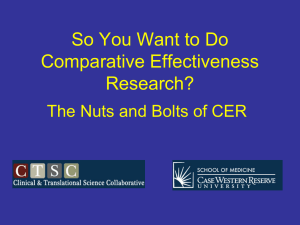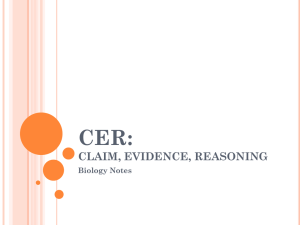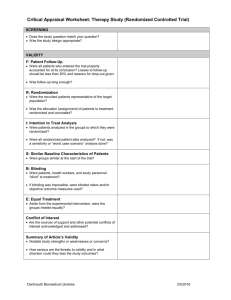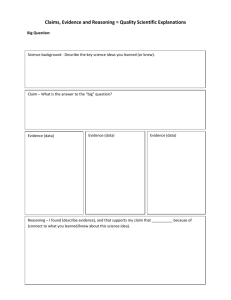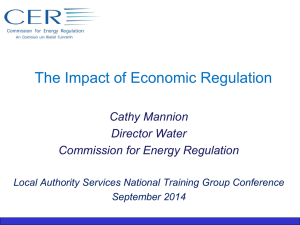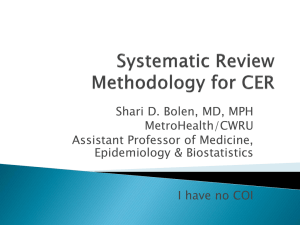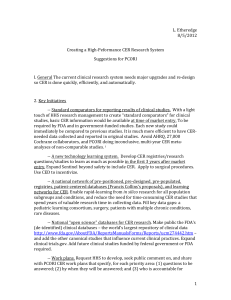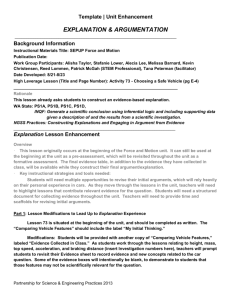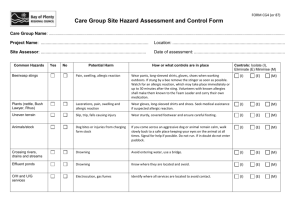Innovation, Life Expectancy, and Health:
advertisement
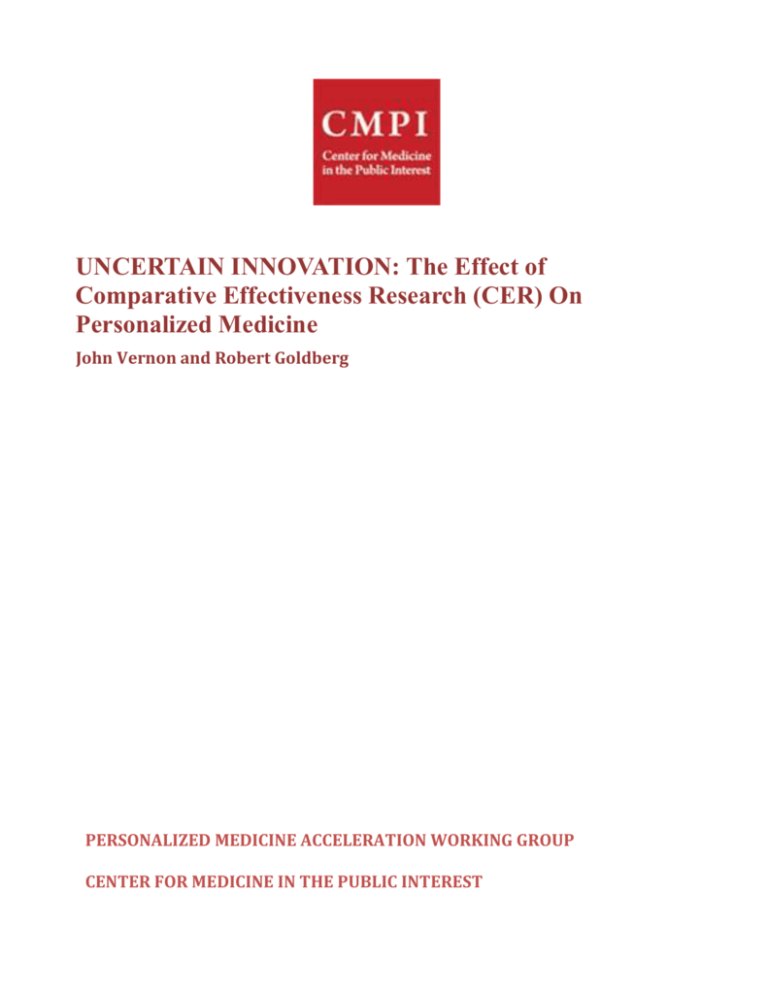
UNCERTAIN INNOVATION: The Effect of Comparative Effectiveness Research (CER) On Personalized Medicine John Vernon and Robert Goldberg PERSONALIZED MEDICINE ACCELERATION WORKING GROUP CENTER FOR MEDICINE IN THE PUBLIC INTEREST Foreword Is comparative effectiveness the same thing as cost effectiveness? No. There’s a big difference. Cost effectiveness is what NICE (The United Kingdom’s National Institute for Clinical Excellence) does based on, among other things, the infamous $50,000 per year of life measure known as QALY or Quality Adjusted Life Year. Cost effectiveness assumes an additional year of life is worth about $50,000, the average price of a fully-loaded Land Rover. For example, NICE’s preliminary decision was that four new cancer drugs to treat people with kidney cancer that has spread—temsirolimus (Torisel), bevacizumab (Avastin), sorafenib (Nexavar), sunitinib (Sutent)—should not be reimbursed by the National Health Service because, despite clinical evidence that these drugs can actually help, they weren’t “cost effective.” In essence, NICE doesn’t think that these four drugs are a good value for the NHS. Currently, the only available treatment for metastatic renal cell cancer is immunotherapy. This halts the disease’s progress for just four months on average. But if people are unsuitable for immunotherapy, or it doesn’t work, that’s it. There’s no other treatment option. NICE agreed that patients tended to live longer when they were given these drugs. But when they put the data from the trials into their QALY-driven computer models, they found that the drugs cost a lot at £20,000 to £35,000 ($39,000 to $68,000) per patient per year compared to the benefit they brought patients – too much for them to recommend that the NHS prescribe these drugs. The result? The government saves money and patients receive an expedited death sentence. That’s not hyperbole, that’s cost effectiveness. Comparative effectiveness is different. The key word is “comparative.” Comparative effectiveness strives to show which medicines are most effective for any given disease state. Is there a “more effective” statin? A “more effective” treatment for depression? Most of the world refers to comparative effectiveness as Healthcare Technology Assessment. But how do you compare two molecules (or three or more) that have different mechanisms of action for patients that respond differently to different medicine based on their personal genetic make-up? Comparative effectiveness in its current form leads to a “one-size-fits-all” approach to healthcare, which means that it doesn’t fit anyone all that well. The concept it good, but the tools 2 are wrong. Comparative effectiveness relies heavily on findings from randomized clinical trials. While these trials are essential to demonstrating the safety and efficacy of new medical products, the results are based on large population averages that rarely, if ever, will tell us which treatments are “best” for which patients. This is why it is so important for physicians to maintain the ability to combine study findings with their expertise and knowledge of the individual in order to make optimal treatment decisions. Government sponsored studies that conduct head-to-head comparisons of drugs in “real world” clinical settings are regarded as a valuable source of information for such coverage and reimbursement decisions—if not for making clinical decisions. Two such studies, the Clinical Antipsychotic Trials in Intervention Effectiveness (CATIE), study and the Antihypertensive and Lipid-Lowering Treatment to Prevent Heart Attack Trial (ALLHAT) study, were two such “practice-based” clinical trials, sponsored in part by the National Institutes of Health, to determine whether older (cheaper) medicines were as effective in achieving certain clinical outcomes as newer (more expensive) ones. The findings of both CATIE and ALLHAT were highly controversial, but one thing is not: even well-funded comparative effectiveness trials are swiftly superseded by trial designs based on better mechanistic understanding of disease pathways and pharmacogenomics. And, since most comparative effectiveness studies are underpowered, they don’t capture the genetic variations that explain differences in response to medicines by different patients. As John Vernon and Robert Goldberg show, comparative effectiveness focuses only on cost and creates uncertainty about whether investments in personalized medicine will yield returns for companies and benefits for patients. Substituting CER for personalized medicine will reduce investment in innovation, the number of new treatments and the social value of health that better technologies yield. A health technology assessment model for the 21st Century should reflect and measure individual response to treatment based on the combination of genetic, clinical, and demographic factors that indicate what keep people healthy, improve their health, and prevent disease. It would recognize that most of the value of new technologies flows directly to patients. And it should not be a barrier to using new treatments as soon as possible. Doing so will reduce incentives for innovation. In an era of personalized medicine, one-size-fits-all treatments and reimbursement strategies are already dangerously outdated. We are early in this debate, but at least we can all agree that this is not, and must not be exclusively, a debate about saving money. It must be about accelerating the commercialization of personalized medicine. This paper provides a platform and perspective from which to start such an effort. Peter Pitts President, Center for Medicine in the Public Interest May 30, 2012 3 Uncertain Innovation: Effect of Comparative Effectiveness Research (CER) On Personalized Medicine Abstract Comparative effectiveness research (CER) is a proposed response to what proponents regard as the market’s failure to produce the quantity of comparative assessments of medical technology consumer value. We discuss this claim in terms of prospect theory. We find that CER creates a different frame for making decisions about risk and gains that, in turn, changes perspectives on the expected returns and effective patent life of medical research and development. Further, we compare CER’s impact on rates of innovation to the effect of choices framed by biomarker-based information or personalized medicine has on research and development (R&D). We estimate that the shift in frames will cause a decline and loss in R&D innovation over ten years in terms of between $38-74 billion and would reduce the number of 57 new products over the decade. We conservatively estimate that the foregone social value of biomarker-based innovation would be $10 trillion over ten years. Introduction Under the Patient Protection and Affordable Care Act (PPACA), the government will support, sponsor, use, and disseminate information on the comparative effectiveness of medical technologies in treating illnesses or improving outcomes. The principal justification for a robust CER enterprise is the fact that government regulation can, in special cases, improve market outcomes, through regulations that reduce information asymmetries that lead to market failures. (By asymmetry, economists mean a situation where one party to a transaction has more or better information than the other party.) It implies that the party with less information will incur losses because of the greater knowledge the other party has about the transaction. Securities and Exchange Commission regulations that require audited financial statements and other disclosures for public companies, Food and Drug Administration statutes that make submission of clinical data on the safety and efficacy of medicines and devices, and federal non-discrimination laws in housing are all examples of how our government seeks to reduce information asymmetry to minimize losses we might incur as a result of decisions made absent such knowledge. The Patient Centered Outcomes Research Institute (PCORI) and requirements under PPACA for increased production, distribution, and use of CER in healthcare transactions are similarly justified as a response to information asymmetry. CER is already being used by the Centers for Disease Control to determine whether national vaccine programs should cover new immunizations. The Centers for Medicare and Medicaid Services use CER to make coverage This research was supported by a grant from the Ewing J. Kauffman Foundation and conducted for the Personalized Medicine Acceleration Working Group, a project of CMPI. The working group and its final report, “From Promise to Performance: Accelerating the Commercialization of Personalized Medicine,” was also supported by the Kauffman Foundation. 4 decisions about new drugs and devices. The Independent Payment Advisory Board – empowered to make cuts in Medicare spending by regulating the adoption and use of new techologies -- will use CER. Regulatory advocates believe that CER will allow government bureaucrats can do a better job than the market at product information aggregation, consumer benefit measurement, and relative pricing. Proponents of greater regulation in the pharmaceutical industry specifically, and healthcare generally, will argue that free markets do not work well for the pharmaceutical industry, because consumers cannot properly judge the value of complex, high-technology goods. From this perspective, CER is not only essential to the effective implementation of PPACA, but its most important activity. Advocates argue that without such knowledge, consumers and health plans will choose inputs that do not maximize value. In stating that CER solves market imperfections, proponents assume that the production of comparative evaluations will lead to better decisions and an optimal allocation of limited health resources. However, CER does more than increase information. The CER enterprise is designed to substitute one set of perspectives and expectations on the part of decision makers (consumers, doctors, health plans, producers) about the relative risks and gains from new technology for another. CER and Prospect Theory: Framing and The Asymmetry of Loss CER is not producing more information as much as it is substituting one form of information for another. As created and used in the United States and other health systems, CER produces information for making societal decisions about resource allocation at the expense of the production of other types of information that reflect other perspectives and values. CER, therefore, creates a benchmark with an entirely new set of expectations about what they can know and what can be known. As prospect theory demonstrates, this shift in knowledge has a cumulative effect on perceptions of the relative risk or uncertainty of incurring a loss. In other words, the introduction of CER leads to asymmetry of loss and risk avoidance that causes people or firms to take actions to reduce or avoid loss rather than maximize gain. Indeed, the production of CER also uses a difference reference point. Prospect theory demonstrates “there is much evidence that variations in the framing of options (e.g., in terms of gains or losses) yield systematically different preferences (Tversky and Kahneman, 1986). Specifically, CER is based on utility theory. However, CER involves choices of what information to produce, how to produce information, and expectations of how information will be used and what outcomes will emerge. In prospect theory, the introduction of new knowledge, as well as both the type of knowledge and the time when it is introduced, can change the frame by which risk and losses are judged. In turn, preferences will change. For example, researchers looked at the effects of information presentation (framing) on women’s perception of fetal risk, and their intention to use a safe drug during pregnancy. One-half the women received negatively framed information (1 3% chance of having a malformed child); the other one-half received positively framed information (97 99% chance of having a normal child). Women in the negative group had a significantly higher 5 perception of teratogenic risk (14.9%) than those in the positive group (8.3%) and were less likely to want to take the drug (Jasper, 2001). Similarly, in making investment decisions, researchers have found that a narrow frame - making a decision separate from prior choices and outcomes - leads to risk aversion and suboptimal investment outcomes. Further, when two decisions are separated by time, instead of in combination, increases the narrowness of a frame since both choices are also made in isolation of the other. The framing of decisions in this manner, as well as the type of information presented, will lead to different conceptions of the acts, outcomes, and contingencies of a particular choice (Thaler, 2002). In previous research, we developed a simple model to look at the effect of having to produce CER on the amount of medical and biopharmaceutical innovation. We found that CER reduces levels of investment in innovation. Since there is a robust and positive association between average R&D productivity and increased health capital, we were able to broadly estimate the impact of CER on lives saved and the social value of new technologies. CER Frames and Induced Risk Aversion We build upon some of our previously published results by considering the question of how different types and distribution of information affects the frame of investment decisions. First, we assume that CER increases uncertainty and in a seeming paradox, also increases the frequency of decision makers persisting or even escalating resources committed to a course of action, even when persistence or escalation clearly is not justified by future return calculations. Both behaviors are examples of the increase in choices designed to avoid loss in the face of uncertain gains. In the case of sunken costs, it seems less risky to put more money in an existing product to avoid the possibility of total loss by shifting resources to another activity. Put in another way, CER not only increases out-of-pocket costs, it raises opportunity costs in the shortterm which leads to sticking it out to avoid a sure loss and increases them for the long-term because future investment will decline steeply in response to increased uncertainty. The shift is a function of the fundamental asymmetry of CER that requires decisions. Decision makers are more likely to invest in the safer return and put less at risk over a longer time horizon. Such risk seeking is prevalent when people must choose between a sure loss (abandoning a project or investment) and a substantial probability of a larger loss (having to stop one project and having to start another.) The possible impact of CER framing could be significant. A large body of empirical evidence demonstrates returns to medical innovation to be astonishingly high. These findings show that the economic value of medical and biopharmaceutical research and innovation - not just the value of past efforts and innovations, but the likely prospective value of future efforts - make these research activities among perhaps the most productive uses of society’s resources. Second, we compare the impact of CER on innovation with the introduction of another type of information that increases the potential value of medical innovation and therefore, changes the predictability of losses and gains. Specifically, we ask what the effect of biomarkers that can be used to measure treatment response will be on the innovation investment decision. The predictive measurement of biological causation from underlying disease mechanism creates an 6 objective baseline prediction tool for determining the success of a specific investment or portfolio of investments. It both broadens a decision frame and reduces the time between decisions about product development and the benefit of one choice in context of other projects. Organizing investment decisions in this fashion, a stratified proof of concept (sPoC) model, “allows active feedback between discovery research, Phase I and Phase IIa trials and postmarketing surveillance, and includes the potential development of biomarkers to identify those patients who might be more likely to experience adverse events. There are instances with such models in which a change in the administration regimen of the drug or the selection of an alternative drug has provided greater benefit to particular patients” (Douglas, 2010). Scaled proof of concept also used feedback from post-marketing surveillance studies to fuel the continued search for new targets, biomarkers, and an understanding of off target effects. These activities are crucial in the search for the right therapy for the right patient, and will heighten the sense of urgency to get drugs (and devices) to patients. The use of biomarkers in sPOC decisions improves understanding of the clinical performance of a product and how many people will benefit. These factors influence the size, cost, and duration of clinical trials positively. Indeed, empirical studies show the ability to rely on a predictive biomarker, and companies can generate a higher risk-adjusted expected net present value of a product. Adding in a retrospective biomarker-based evaluation of patient response after a drug is approved, reduces value if the increased therapeutic effect is unlikely to increase price or market share. CER is information generated after a product is developed. CER also focuses on a narrow issue cost effectiveness - in an ambiguous way. As other researchers have noted, CER does not include information about the genetic, biological, and clinical factors that cause variations in treatment response (Meltzer, 2010, Gabler 2007, and Horn 2009). Indeed, the framing of issues by CER focuses on the value of a new treatment to a small group of decision makers with a specific perspective to the exclusion of, and in isolation from, the other. In contrast, biomarker driven decision-making is part of the development process; real time information on treatment, and dose response is used to optimize investment in a product. At the same time, the information of biomarker driven decisions promotes a broad frame by embedding investment decisions in a sequence of similar choices or predictions. Finally, biomarkers reduce the risk of treatment and increase value to consumers by increasing confidence in the outcomes of treatment decisions. 1 CER does not formally measure the value of reducing loss from disease or inaccurate treatment. Indeed, the demand for comparative research on the clinical effect of one treatment to another that ignores biomarker predictive variation in treatment numbers and response adds uncertainty to the investment process. In fact, biomarker-based development is discouraged when the prior confidence in the predictive biomarker is weakened by post-approval requirements for information that ignore the stratified results in favor of a one size fits all comparison of a personalized product with other treatments. 1 The relationship between the effect of biomarkers on consumer expectations of losses and gains and investment decisions by companies deserves more consideration by both firms and economists. 7 The information CER produces undermines decision making based on personalized medicine by both substituting early evidence from predictive biomarkers with data that ignores variation in therapeutic effect and demanding clinical trials to once again prove the clinical utility of a treatment already established as effective at earlier development stages. A study on the value of personalized medicine cited “an increase in regulatory evidentiary standards...resulting in increased development times and costs”. This shift in perspective, along with government restrictions on access and payment for new ‘untested and risky’ technologies has a cumulative and negative effect on decision weights. It creates uncertainty and increases risk of returns. It results in cash flow declines and the costs of capital climb. In this scenario, the effective net present value (NPV) -- how much an investment's future cash inflows are worth today minus the costs of the investment.-- of personalized medicine declines dramatically from $1 billion to -$225 million “ (Truesheim, 2011). Indeed, a large body of research has shown the value of innovations that extend life and improve well-being (reducing significant loss and uncertainty) that generate substantial social and economic value, value ignored and even excluded by the frame established by CER (Vernon, 2010, Lichtenberg, 2002, Murphy and Topel, 2006). By comparison, personalized medicine increases the number of predictable responders to a treatment. If regulators integrate this predictive knowledge, it can also speed up and reduce the cost of commercializing a product. These factors increase the value of a product and, by reducing uncertainty and direct spending, reduces the cost of capital. The same study found that under this ‘frame’ the NPV of personalized medicine goes from $1 billion to $10 billion. “In such an environment, advances in biomarker -based understanding, routinely attracts translational investments that lead to the development of personalized medicines, thereby benefitting affected patient subpopulations" (Truesheim, 2011). Surprisingly, the possibility that using a CER frame could discourage investment has not been widely analyzed. As Daniel Kahneman observes: The errors of theory are not found in what they assert explicitly, they are hidden in what is implied or ignored. In the case of CER, that which is both hidden and ignored frames investment decisions. This exclusion is further compounded by the fact that one entity and a small group of individuals are deciding what is to be evaluated. The CER process eliminates other reference points, reinforcing what Kahneman calls ‘theory induced blindness:’ “once you accept a theory and use it as a tool in your thinking, it is extraordinarily difficult to see its flaws” (Kahneman, 2011). This is particularly the case when the asymmetry created in framing an issue has in its design, as is CER, to achieve a specific policy objective. Our paper, therefore, is an effort to demonstrate the consequences of CER produced framing on R&D investment decisions and contrast its impact on innovation and health capital with that of biomarker-produced information. In the next section, we develop an economic framework for analyzing the potential impact of CER on innovation incentives. Much of this is standard investment theory. We develop the economic framework in an applied fashion to consider CER policies and identify two principal ways it is likely to directly impact R&D investment incentives. This is done in a straightforward, non-technical manner at a high level. Section 3 presents our analyses. Because 8 we recognize the hypothetical nature of most of this work, we adopt a strategy of employing conservative assumptions throughout the analysis. Thus, our results are intended to represent a lower bound measure. This is the context within which our results should be considered. The last section discusses our findings more broadly and concludes with a simple, but extremely critical point regarding healthcare legislation that fails to consider its effect on future rate and direction of medical and biopharmaceutical innovation. Foundations and Perspectives of the Conceptual Economic Model In order to generate quantitative measures of how various configurations of a U.S. CER policy (or other legislation) will impact private-sector research and development investment levels, and perhaps even present-value monetary approximations of the economic costs, Americans will bear, as a result of these policies in the long run, a foundation and analytic framework built on economic logic and theory is imperative. To do this, we begin by first considering the traditional firm investment problem. Starting Point: Uncertainty, Expectations & Firm Perspective The launching-off point for any sound, analytic examination of how a new regulation, policy, or other exogenous event (that affects the biopharmaceutical industry’s structure, conduct, or performance) impacts the rate and direction of future research and thus innovation must be the firm perspective. This is because firm investment in R&D is the principal endogenous variable influencing (or determinant of) industry innovation2. Endogenous growth theory holds that investment in human capital; innovation, and knowledge are significant contributors to economic growth. As Frank Lichtenberg points out in his seminal work, the technical progress generated by pharmaceutical R&D is embodied in new drugs and can only increase productivity if produced, sold, and consumed (Lichtenberg, 2002). Furthermore, investment, and in the current context investment in biopharmaceutical R&D, is driven (determined) by expectations; more precisely, it is determined by expectations of the future economic returns to investing in a particular R&D project (such a project may be, of course, one among a large portfolio of firm R&D projects). Hence, expectations regarding the likelihood of loss will directly affect rates of innovation and its contribution to productivity. A project’s expected internal rate of return (IRR) is assessed relative to the project’s expected opportunity cost of the investment funds. Expectations are formulated about future (after-tax) cash flows and the riskiness of these expected cash flows. Risk, or financial risk in this context, Exogenous factors are, of course, variables that impact an economic system’s equilibrium, but their values are determined outside the system under examination, and by the dynamic behavior-interactions of the system, which are governed by behavioral assumptions, most notably profit maximization; government policy may loosely be considered an exogenous variable from the firm/industry perspective, but lobbying exerts an influence on future regulatory/policy environments; this is a separate discussion. Suffice to say, our approach is one that models CER as an exogenous force that affects firm-industry behavior; and specifically impinges upon R&D investment incentives, this is standard protocol in the literature. 2 9 has a very particular meaning: it is the systematic, non-diversifiable risk, of the project - the project’s opportunity cost of capital. Expected economic returns depend therefore on: (1) expected project net cash flows; and (2) the riskiness of these expected net cash flows. For example, expected project cash flows might have a period of initial cash outlays (e.g., clinical research and development) followed by a period of cash inflows (e.g., net revenues such as product sales, royalties, milestone payments less the costs associated with basic operations, product distribution, and marketing). The theory of investment is universal. There is certain elegant simplicity to the way neoclassical investment theory, and the myriad variables affecting investor and firm3 expected returns, collapses down into the singular metric of present-value dollars.4 Investment expectations represent a convergence of economic information and are ‘framed’ into a quantifiable unit of measurement: cash flows. Future expectations alone drive the rate and direction of investment activities (e.g., R&D investment). Expectations vary by a reference point shaping expectations of possible losses relative to previous returns and cash flow projections of a portfolio. Hence, expectations affect the rate and directions of biopharmaceutical innovation. CER policy will, therefore, impact research investment if these policies impact expectations about future cash flows generated by research activities and their discounted present values. To illustrate graphically, we present Figure 1, which depicts the expected cash flow profiles of a biopharmaceutical R&D project under three hypothetical configurations of a new CER policy in the U.S. 3 These two actors/agents are essentially one and the same because of the fiduciary duties of firms, i.e., senior management have to investors - the singular responsibility of shareholder wealth maximization. 4 The very same phenomenon is of at the heart of price theory: the vast, instantaneous accumulation of information about a market product or service represented by a single price; and by which disparate and independent market participants are signaled. 10 Figure 1: Expected Project Cash Flow Profiles 3 CER Policy Configurations FDA App. A FDA App. B and C E(CF) CER Policy A $50 E(CF) CER Policy B Net Revenues ($MM) E(CF) CER Policy C $0 Launch, Promotion, Peak Sales, Competition Clinical Trials 0 5 10 15 20 25 30 Years If, for example, the e (NVP) of the research project cash flows are >0 under CER policy configurations A and C, but negative under B, then this particular R&D project is unaffected and will move forward in development except in the case of CER policy configuration B. A general way to think about the cause and effect pathway from a new CER policy through the firm investment model we have described, and to the downstream, or long run consequences for innovation is seen in Figure 2. Figure 2: Conceptual Model and General Framework 11 In previous papers (Vernon, Golec, and Stevens, 2010; Vernon, Goldberg, and Pitts, 2011), we identified increasing clinical development costs in Phase III (due to the larger trials that are required to statistically detect product efficacy against a comparator instead of placebo) as the principal factor impacting research investment incentives, because higher clinical development costs, ceteris paribus, reduce expected profitability. We were careful to say that this effect was not contingent upon explicit regulation requiring comparator trials; this impact would occur if, implicitly, CER induced a political or competitive change within the industry that caused there to be substitution, in some fraction of cases, towards comparator-controlled trials instead of placebo-controlled trials. Alternatively, the same effect would be generated by a similar change in expectations that more Phase IV trials would be required on average. As amply discussed, the current paper considers a second factor that is likely to have a significant impact on expected investment returns from biopharmaceutical research: longer clinical development times resulting from CER requirements or pressures (explicit or implicit) to design and run trials using containment of government healthcare costs as a primary research endpoint at the expense of biological and patient reported measures of benefit to determine the clinical utility of a product for specific groups of patients. CER information and the requirement to obtain it will require more resources and longer clinical trial and development periods, on average. As we have shown previously, this will both delay access to new medicines for patients and it will affect research investment incentives, because it impacts expected cash flow profiles: there will be a delay in time before R&D generates positive cash flows and the effective patent life (the time a new drug has before generic competition) will be shortened, all else unchanged. Second, the additional risk CER imposes on investment decisions generates more aversion to loss; capital is shifted away from riskier, more innovative products to those that seem to be less risky or a safer bet. One way to conceptualize the impact CER has on the amount of time and money invested in R&D, as well as the willingness to invest in innovative products, is to look at the impact of the demand for greater precision and more information on the safety of medicines to treat obesity, diabetes, and opportunistic infections. As the ‘frame’ for product approval shifted to emphasize safety above all else (or as one politician put it, to ensure that every drug is 100 percent safe!), not only have marginal costs of obtaining more precision exceeded the marginal opportunity cost of obtaining that precision, the opportunity costs increase as well. As the safety ‘delta’ becomes steeper and unpredictable (because of political pressure, media attention, etc.), companies not only invest less in innovative products, but at the same time they seek safer bets (no pun intended). That means investing in products that are marginally better on average than other products but are at least perceived as safer. It also means more investment is made in products already in development to meet additional safety concerns. CER affects innovation in a similar fashion. It does not merely increase the cost of the studies needed to reduce the confidence intervals (uncertainty) around shifting standards of cost effectiveness and also the increased risk associated with the need to acquire this information 12 based on the narrow frame of a government agency with a focus on cost can discourage or produce suboptimal investment in innovations and future cures. This inevitable tradeoff is ignored in many contexts and forums on CER and is certainly neglected by the agencies funding CER. The economic costs of forgone innovation due to policy or theory induced blindness may not be measured as precisely as the efficacy of an existing medicine to treat high blood pressure (for the obvious reasons), it is not precision that is needed to make our critical point. We turn to this next. Calculating the Impact of CER Investment in R&D The impact that comparative effectiveness regulations and/or polices may have on industry-level R&D expenditures will depend largely to two key factors. Firstly, how CER will impact, directly or indirectly, the cost of drug development, but more specifically, the expected cost of drug development through a substitution effect from placebo-controlled clinical trials towards comparator-controlled trials, or simply more comparator-controlled trials. This can occur through direct requirements by the FDA or another federal entity; most likely its effect will be implicit: through the political and economic influences CER has - intentional or not - on the standard of clinical evidence necessary for a drug to be “safe and effective.” This is a sufficient condition for CER to impact research incentives through higher expected drug develop costs. These higher expected costs might be because of a higher number of comparator-controlled clinical trials, either in lieu of placebo-controlled trials or in addition to them. For these reasons alone, firm incentives to invest in R&D will decline, ceteris paribus: a greater share of potential investment projects will have negative NPVs as we demonstrated. Operationally, we measure this effect through the effect higher drug development costs have on pharmaceutical profit margins which has a well-known and predictable impact on R&D spending levels. Our empirical methods and statistical models have been described in some of our earlier publications (Vernon, Golec, and Stevens, 2010; Vernon, Goldberg, and Pitts, 2011). The second factor is the impact CER will have on drug development times, because it can delay product launches and reduce effective patent life. Patents are awarded in the discovery research stage; hence, by the time a new drug reaches the market, it may have only eight (8) years remaining on its 20-year patent. Following patent expiration, generic competition is fierce and quickly erodes most the branded drug’s market share. For large-selling products on average, one year after patent expiration and thus, generic entry, 90 percent of the branded product’s market share has been eroded (Saha and Grabowski, 2007). As a consequence, a single year reduction in expected effective patent life, independent of opportunity costs of investment funds associated with a backward shift in the cash flow life cycle profile, can very significantly affect a research program’s NPV. Therefore, a CER-induced increase in expected clinical development times for R&D projects, both shifts backward the life-cycle cash flow profile and truncates its right tail, because of less time on the market with a patent. This severe drop in investment in response to uncertainty about patent life is consistent with prospect theory. It reflects the response of decision makers who are forced to accept a high probability of “making things worse in exchange for a small hope of avoiding a large loss” (Kahneman, 2011). We believe that the rapid falloff of investment in new products is a result of 13 companies pouring more into products already under development in response to a near term refusal to accept a loss and, in the long term, risk aversion to the possibility of a large loss in the future. Effective patent life has long been recognized as a theoretical determinant of R&D investment incentives. We believe that prospect theory reinforces the role of patent life in decision making about innovation. Hence, our analyses, using the data sample from our earlier studies that measured the empirical relationships between Phase III clinical development costs, pharmaceutical business segment profit margins, and R&D expenditures, we now also consider the additional, and linearly additive effect of reduced effective patent lives and market exclusivity periods have on R&D investment. These results have been published previously (Vernon, Golec, Lutter, et al., 2009) and document a unit elastic relationship between effective patent life length and R&D expenditures. Thus, for example, a ten percent (10%) reduced (expected) effective patent life for biopharmaceutical would be associated with (cause) a ten percent (10%) reduction in R&D investment. This results, theoretically, because the expected shorter period of time on the market before patent expiration results in some R&D projects, which previously had positive expected NPVs, becoming negative NPVs, and thus being terminated. The details of our calculations, the statistical models upon which they are based, and our data samples have been discussed and presented elsewhere. What we present next are the results obtained by using the same method. In the tables that follow, we report results from scenarios in which clinical development costs (Phase III specifically) increase on average (are expected to increase) from zero percent to 50 percent as a result of CER policies; this is considered simultaneously with expected increases in Phase III clinical development times that range from 0 to 12 months. Increased clinical development times could result from a certain degree of substitution away from surrogate endpoints in clinical trials towards clinical endpoints, as a result of possible CER policy configurations. We have been conservative in our analyses and estimates in two ways: we do not take into account that increased development times suppress the effect internal financing and cash flows have on R&D investment. In virtually every study of the determinants of biopharmaceutical R&D expenditures and cash flows, because of capital market imperfections and a lower cost of capital associated with internally-generated funds, have been found to be a statistically significant and very influential factor in the level of firm and industry R&D investment (see, for example, Grabowski, 1968; Scherer, 1996). We do not consider this effect in our current analyses and this makes our estimates conservative. A second major reason our results should be viewed as conservative is because we do not consider the additional costs associated with CER endpoint studies relative to biomarker -based R&D. We conservatively assume these additional costs to be zero and we only measure the effect of increased risk and uncertainty by measuring the impact the delayed time to market and thus shorter effective patent lives (expected on average) will have on risk aversion and thus investment in innovation. Put another way, our analysis captures a conservative estimate of the 14 amount of innovation and health capital forgone by pursuing CER driven information instead of biomarker driven knowledge. Table 1 reports the decline in industry R&D-to-sales under multiple CER impact scenarios. The sample average R&D-to-sales ratio was 17.5 percent. 15 Table 1: Impact of CER Policies on Industry R&D Investment Spending by Scenario (CER Effect on Average Phase III Development Costs and Length) No Change in Phase III Length No increase in Phase III Cost 3month increase 6 month 9 month 12 month increase increase increase 0.00000 -0.00438 -0.00875 -0.01313 -0.01750 10 % increase in Phase III Cost -0.00340 -0.00778 -0.01215 -0.01653 -0.02090 20 % increase in Phase III Cost -0.00680 -0.01118 -0.01555 -0.01993 -0.02430 30 % increase in Phase III Cost -0.01020 -0.01458 -0.01895 -0.02333 -0.02770 40 % increase in Phase III Cost -0.01360 -0.01798 -0.02235 -0.02673 -0.03110 50 % increase in Phase III Cost -0.01700 -0.02138 -0.02575 -0.03013 -0.03450 These declines in R&D may also be reported as percentage declines in R&D, ceteris paribus, by substituting the CER frame for a biomarker -based frame. This is shown in Table 2. 16 Table 2: Impact of CER Policies on Industry R&D Investment Spending Percentage by Scenario (CER Effect on Average Phase III Development Costs and Length) No Change in Phase III Length 3 month increase 6 month 9 month 12 month increase increase Increase No increase in Phase III Cost 0.0% -2.5% -5.0% -7.5% -10.0% 10 % increase in Phase III Cost -1.9% -4.4% -6.9% -9.4% -11.9% 20 % increase in Phase III Cost -3.9% -6.4% -8.9% -11.4% -13.9% 30 % increase in Phase III Cost -5.8% -8.3% -10.8% -13.3% -15.8% 40 % increase in Phase III Cost -7.8% -10.3% -12.8% -15.3% -17.8% 50 % increase in Phase III Cost -9.7% -12.2% -14.7% -17.2% -19.7% These declines in R&D can more usefully be shown in dollar declines, all else held constant, by considering the fact that 2010 total industry R&D spending equaled approximately $67 billion (PhRMA Industry Profile, 2011). 17 Table 3: Impact of CER Policies on Industry R&D Investment Spending by Scenario (CER Effect on Average Phase III Development Costs and Length) No Change in Phase III Length 6 month 9 month 12 month 3 month increase increase increase Increase No increase in Phase III Cost $0.0 Billion -$1.7 Billion -$3.4 Billion -$5.0 Billion -$6.7 Billion 10 % increase in Phase III Cost -$1.3 Billion -$3.0 Billion -$4.7 Billion -$6.3 Billion -$8.0 Billion 20 % increase in Phase III Cost -$2.6 Billion -$4.3 Billion -$6.0 Billion -$7.6 Billion -$9.3 Billion 30 % increase in Phase III Cost -$3.9 Billion -$5.6 Billion -$7.3 Billion -$8.9 Billion -$10.6 Billion 40 % increase in Phase III Cost -$5.2 Billion -$6.9 Billion -$8.6 Billion -$10.2 Billion -$11.9 Billion 50 % increase in Phase III Cost -$6.5 Billion -$8.2 Billion -$9.9 Billion -$11.5 Billion -$13.2 Billion Finally, because the effect CER policies have, it will not be transitory but rather will represent a real shift in the industry R&D landscape (unless they are repealed or abolished), we can consider the effect on R&D expenditures over a longer time horizon. We conservatively consider a 10year time horizon and calculate the 10-year reduction in R&D investment resulting from the negative effects of CER on expected returns to research and development (and many previously positive expected NPV-R&D projects will become negative NPV projects that get terminated). These estimates are shown below in Table 4 and where future years forgone R&D spending is discounted at a 12 percent cost of capital. 18 Table 4: Impact of CER Policies on Industry R&D Investment Spending over 10 Years by Scenario (CER Effect on Average Phase III Development Costs and Length) No Change in Phase III Length 3 month increase 6 month 9 month 12 month increase increase Increase No increase in Phase III Cost $0.0 Billion -$9.5 Billion -$18.9 Billion -$28.4 Billion -$37.9 Billion 10 % increase in Phase III Cost -$7.4 Billion -$16.8 Billion -$26.3 Billion -$35.7 Billion -$45.2 Billion 20 % increase in Phase III Cost -$14.7 Billion -$24.2 Billion -$33.6 Billion -$43.1 Billion -$52.6 Billion 30 % increase in Phase III Cost -$22.1 Billion -$31.5 Billion -$41.0 Billion -$50.5 Billion -$59.9 Billion 40 % increase in Phase III Cost -$29.4 Billion -$38.9 Billion -$48.3 Billion -$57.8 Billion -$67.3 Billion 50 % increase in Phase III Cost -$36.8 Billion -$46.2 Billion -$55.7 Billion -$65.2 Billion -$74.6 Billion Table 4 can be used to illustrate an instructive point. A CER policy that results in either: i) a 40 percent increase in (expected) average phase III clinical development costs and a 12 month increase in (expected) average clinical development times; or ii) a 50 percent increase in (expected) average phase III clinical development costs and a 9 month increase in (expected) average clinical development times will result in a level of forgone biomarker -based R&D approximately equal $67 billion which is the industry’s entire 2010 investment in R&D. Even with very conservative assumptions and many factors suppressed completely and thus modeled as having no effect (such as cash flow effects and the additional costs of clinical endpoint trials relative to surrogate endpoint trials), the levels of forgone research remain very substantial. Assuming that the average new molecular entity (NME) costs $1.3 billion, these 10year R&D reductions may be translated to a rough approximation of the cost of CER in terms of fewer numbers of new drugs being developed and brought to market. This is shown in Table 5. 19 Table 5: Impact of CER Policies on the Number of New Drugs Developed by Scenario (CER Effect on Average Phase III Development Costs and Length) No Change in Phase III Length 3 month increase 6 month 9 month 12 month increase increase Increase No increase in Phase III Cost 0 NMEs -7 NMEs -15 NMEs -22 NMEs -29 NMEs 10 % increase in Phase III Cost -6 NMEs -13 NMEs -20 NMEs -27 NMEs -35 NMEs 20 % increase in Phase III Cost -11 NMEs -19 NMEs -26 NMEs -33 NMEs -40 NMEs 30 % increase in Phase III Cost -17 NMEs -24 NMEs -32 NMEs -39 NMEs -46 NMEs 40 % increase in Phase III Cost -23 NMEs -30 NMEs -37 NMEs -44 NMEs -52 NMEs 50 % increase in Phase III Cost -28 NMEs -36 NMEs -43 NMEs -50 NMEs -57 NMEs These results place the potential cost of the informational asymmetry of substituting the current frame of CER policies and regulations for biomarker -based information. CER is motivated by a desire to “bend the cost curve.” But these efforts will necessarily come at a cost: reduced research investment incentives, less R&D investment, and fewer new medicines in the future. These costs, under several hypothetical and conservative scenarios, are reflected in Table 5. Yet it is also possible to “translate” the foregone biomarker -based R&D into other useful metrics such as life years and present value dollar costs. This was the approach we adopted in our previous paper with the necessary caveats that must accompany any such first approximation estimate. In that paper, we demonstrated, again using conservative assumptions, how $3 billion in forgone present value R&D could be mapped into life years lost in terms of a reduced rate of increase in U.S. life expectancy and into present value dollars using standard valuations of a U.S. life year. Our current analyses contain scenarios (e.g., a 50 percent increase in (expected) average Phase III development costs and a 12-month increase in (expected) clinical development 20 times and recent life year valuations of $175,000/life year) that translate into a present value cost, due to the value of forgone R&D (in perpetuity), in excess of $10 trillion. There is no question the stakes are very high and that CER represents a clear and present danger to biopharmaceutical innovation and thus the welfare patients in the U.S. We do not intend our estimates to be taken as precise measures by any means. Rather, our intention is to show that under conservative assumptions, the order of magnitude of the potential long run costs is very substantial, and should not be ignored. These findings are the result of two very simple facts: 1. 2. R&D investment is sensitive to expected returns, and CER represents a significant threat to expected returns through more costly and longer Phase III clinical development programs; and The measured retrospective and prospective value of biopharmaceutical research and innovation is extraordinarily large; perhaps representing the highest marginal social rate of return of any economic activity in the U.S. economy. Conclusions and Discussion Proponents of CER claim that “the private sector generally will not produce as much research on comparative effectiveness as society would value” (Orszag, 2007). However, in making this assertion, advocates want CER to focus on a narrow goal to the exclusion of other considerations, particularly how the introduction of CER itself will affect the rate of innovation they wish to study and compare. Our research examines the impact of the CER process on the perceptions investors in innovation have on the estimate of risk and gains flowing from their decisions. In addition to establishing that CER will increase the direct cost of innovation, we also conducted a thought experiment to determine if CER’s emphasis on narrow frame of whether a new technology will add cost of the new PPACA and the requirement to make that decision in isolation from others and at a temporal distance from other judgments also has an effect on innovation rates. To underscore the importance of framing to risk perception and behavior, we measure the value of innovation forgone by using a CER frame rather than a biomarker -based frame that provides early and contiguous benchmarks for predicting success. Personalized medicine reduces risk and increases certainty, thereby increasing the rate of R&D investment. As Lichtenberg has observed, R&D is the principal source of economic growth, and the medical technology industry is the most R&D-intensive sector of the economy. The contribution of medical R&D to longevity increases (hence to economic growth) has been demonstrated by establishing a connection between innovation intensity and changes in life expectancy and morbidity (Lichtenberg, 2002). The increase in longevity flows not just from treating people who are sick, but also from technological progress that, to paraphrase Lewis Thomas, lead to improvements of health capital or in the built-in durability and sheer power of humans (Thomas, 1973). Reducing exposure to disease and disability, allows more people to earn a living over a longer period of time and enjoy pursuits associated with leisure time. The ability and willingness to invest in our life experience, knowledge, inventiveness, and enthusiasm in order to, or because we can live longer and healthier lives, generates demand for goods and services. 21 Biomarker-driven or personalized medicine is the technological platform for future gains in life expectancy, well being, and prosperity. Economist, Robert Fogel, notes that because of medical innovations, “healthcare is the growth industry of the 21st century. It will promote economic growth through its demand for high-tech products, skilled personnel, and new technologies, just as electrification spurred economic growth during the first half of the 20th century” (Fogel, 2004). CER is not only blind to the limits of its decision frame, it keeps hidden the consequences of pursuing it by ignoring the role a shift in information and information gathering has on the appetite for risk associated with R&D investment. Even when it is not, the change in frame can still be used to regulate and change decisions. It creates an asymmetry towards risk aversion and betting on the sure thing. As we have shown, CER does so in a way that causes society to forgo the value of innovation by reducing the likelihood the preference will even be articulated and by increasing risk aversion to personalized medicine. The impact on well being and prosperity is significant. 22 References Fogel, R., The Escape from Hunger and Premature Death, 1700-2100: Europe, America, and the Third World (Cambridge Studies in Population, Economy and Society in Past Time) [Paperback] Douglas, F., The Case for Entrepreneurship in R&D in the Pharmaceutical Industry, Nature Reviews Drug Discovery 9, 683-689 (September 2010) Grabowski, H., The Determinants of Research and Development: A study of the chemical, drug, and petrolium industries. Journal of Political Economy, 1968 76 (2) 292-306 Horn, Ph.D., Susan D.; Gassaway, R.N., M.S., Julie, Practice-Based Evidence Study Design for Comparative Effectiveness Research, Medical Care: October 2007 - Volume 45 - Issue 10 - pp S50-S57 Kahneman, D., Thinking Fast, Thinking Slow. Farrar, Straus and Giroux; October 25, 2011 Jasper, J.D., et al., Effects of framing on teratogenic risk perception in pregnant women, The Lancet - 13 October 2001 ( Vol. 358, Issue 9289, Pages 1237-1238 ) Lichtenberg, F., Pharmaceutical-Embodied Technical Progress, Longevity, and Quality of Life: Drugs as "Equipment for Your Health,” NBER Working Paper No. w9351 October, 2002 Murphy, K.M., Topel, R.H., The economic value of medical research. In: Murphy KM,Topel RH, editors. Measuring the gains from medical research: an economic approach. Chicago (IL): University of Chicago Press, 2003: 41-73 Murphy, K. and Topel, R. (2006), “The Value of Health and Longevity” Journal of Political Economy 14(5): 871-904 Orszag, P. (2007), Research on the Comparative Effectiveness of Medical Treatments: Issues and Options for an Expanded Federal Role, CBO, Washington, DC PhRMA: The 2011 Industry Profile, Apr 2011 www.phrma.org/catalyst/2011-industry-profile Saha, A., Grabowski, H, 2006. Generic Competition in the U.S. Pharmaceutical Industry, International Journal of the Economics of Business (Vol. 13, Issue 1, pp. 15-38) Scherer, F. Industry Structure, Strategy and Public Policy (John. Greenman ed., Harper Collins College Publishers,1996) Thaler, R, Barbieri, N., A Survey of Behavioral Finance, NBER Working Paper No. 9222, September 2002 Thomas, Lewis The Lives of a Cell: Notes of a Biology Watcher, Viking, 1974. Trusheim, Mark R., Burgess, Breon, Xinghua Hu, Sean, Long, Theresa, Averbuch, Steven D., Flynn, Aiden A., Lieftucht, Alfons, Mazumder, Abhijit, Milloy, Judy, Shaw, Peter M., Swank, David, Wang, Jian, Berndt, Ernst R., Goodsaid, Federico, Palmer, Michael C. Quantifying 23 factors for the success of stratified medicine. Nature Reviews Drug Discovery 10:11 November 2011 http://www.nature.com/nrd/journal/v10/n11/pdf/nrd3557.pdf Tversky, A., Kahneman, D., 1986. “Rational Choice and the Framing of Decisions.” Journal of Business 59: S251–78. Vernon, J.A., Goldberg R. M., Dash, Y., Muralimohan, G., Alzheimer’s Disease and CosteffectivenessAnalyses: Ensuring Good Value for Money? http://www.actad.org/pdf/Study_Final_051407.pdf Vernon, J.A., Goldberg R. M., Pitts, P. Fewer Drugs, Shorter Lives, Less Prosperity; The Impact of Comparative Effectiveness Research on Health and Wealth Drug Information Journal, Vol. 45, pp. 699–703, 2011 Vernon, J.A., Golec, J.H., Lutter, R., et al., An exploratory study of FDA new drug approval times, prescription drug user fees, and R&D spending. Q Rev Econ Fin 2009; 49: 1260-75 24 About the Authors John A. Vernon, Ph.D. Dr. Vernon is a professor in the Department of Health Policy and Administration at the University of North Carolina at Chapel Hill, where he holds appointments in the Kenan-Flagler School of Business and the UNC School of Pharmacy. He is a Faculty Research Fellow with the National Bureau of Economic Research and a Senior Economic Policy Advisor to the Office of the Commissioner at the U.S. FDA. He has twice testified before the U.S. Senate on pharmaceutical policy issues and advises both government and industry on a wide range of policy issues. He was previously a professor in the finance department at the University of Connecticut and a visiting professor at the Wharton School of Business at the University of Pennsylvania. He also guest edited a special issue of Managerial and Decision Economics on the political economy of the pharmaceutical industry. Dr. Vernon has published articles in numerous publications, including the Journal of Law and Economics, Health Economics, Healthcare Management, the Journal of Healthcare Management, the National Law Journal, the American Journal of Law and Medicine, and the Journal PharmacoEconomics, where he sits on the editorial board. Dr. Vernon holds doctoral degrees from the University of Pennsylvania's Wharton School in Management Science (Health Policy and Management) and the University of London in Economics. Robert M. Goldberg, Ph.D. Robert Goldberg is co-founder and Vice President of the Center for Medicine in the Public Interest (CMPI). Along with Peter Pitts, Dr. Goldberg hosts the popular and controversial blog on the pharmaceutical industry and healthcare, www.drugwonks.com. Prior to founding CMPI, Goldberg was Director of the Manhattan Institute’s Center for Medical Progress and Chairman of its 21st Century FDA Task Force that examined the impact of the FDA’s Critical Path Initiative on drug development and personalized medicine. He is an expert on Medicare reform, comparative effectiveness and FDA’s Critical Path Initiative and the author of many papers, including “Insta-Americans: The Empowered (and Imperiled) Health Care Consumer in the Age of Internet Medicine,” and with John Vernon, “Alzheimer’s Disease and Cost-effectiveness Analyses: Ensuring Good Value for Money?” and “Economic Evaluation and Comparative-Effectiveness Thresholds: Signals to Firms and Implications for R&D Investment and Innovation.” He is also author of “Tabloid Medicine: How the Internet is Being Used To Hijack Medical Science For Fear and Profit” (Kaplan, December 2010). About CMPI The Center for Medicine in the Public Interest is a non-profit, non-partisan organization promoting innovative solutions that advance medical progress, reduce health disparities, extend life and make healthcare more affordable, preventive and patient-centered. CMPI also provides the public, policymakers, and the media a reliable source of independent scientific analysis on issues ranging from personalized medicine, food and drug safety, health care reform and comparative effectiveness. Visit us at www.cmpi.org. 25
